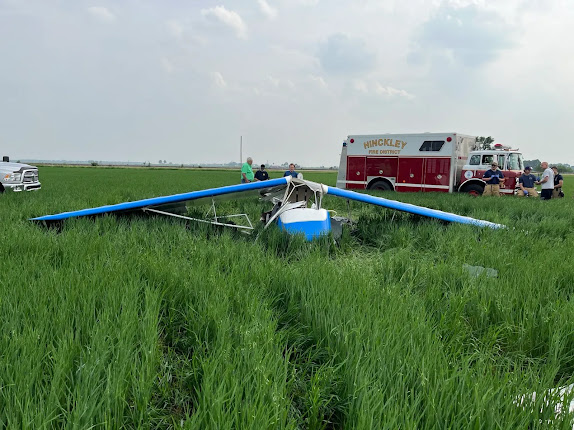On May 5, 2025, about 1940 eastern daylight time, an experimental, amateur-built FFF LLC Express 2000 FT airplane, N519EA, was substantially damaged when it was involved in an accident near Polk, Ohio. The pilot was fatally injured. The airplane was operated as a Title 14 Code of Federal Regulations Part 91 personal flight.
On April 27, 2025, the pilot flew from Delphi Municipal Airport (1I9), Delphi, Indiana, where he hangared the airplane, to Burke Lakefront Airport (BKL), Cleveland, Ohio, to visit a family member.
According to preliminary radar data, automatic dependent surveillance-broadcast (ADS-B) data, and air traffic control (ATC) audio recordings provided by the Federal Aviation Administration (FAA), on the date of the accident, the airplane departed BKL about 1857 under visual flight rules to return to 1I9.
ADS-B data subsequently indicated that the airplane was in cruise flight at 3,000 ft above mean sea level when its flight path became erratic, displaying irregular changes in altitude, heading, and airspeed. This continued until the end of the ADS-B flight track (see figure 1).
The area where the airplane’s flight path became erratic was within an area consistent with heavy precipitation. A Cleveland (CLE) radar controller attempted to contact the airplane via multiple frequencies, with no response. Subsequently, the Mansfield (MFD) local controller (LC) established communication with the pilot who stated that he was trying to land at Ashland County Airport (3G4), Ashland, Ohio. At that time, the airplane was at 3,800 ft. The MFD LC asked the pilot for a pilot report and if he needed any assistance. The pilot reported a rough ride and expressed difficulty with controlling the airplane. The MFD LC then suggested that he fly southbound. There was no response from the pilot.
Radar contact with the airplane was lost shortly thereafter when it was at an altitude of 2,600 ft.
The wreckage was subsequently found in a wooded area near a farmer’s field approximately 3.3 nautical miles northeast of 3G4.
Examination of the accident site and wreckage indicated that the airplane struck a tree limb and then impacted terrain in an approximate 15° nose low attitude while in a right turn. There was no evidence of an inflight fire, explosion, or structural failure, and all the primary flight control surfaces (ailerons, elevator, and rudder), remained attached to their mounts. The wing flaps were up.
Both the left and right fuel tank caps were in place; however, both fuel tanks were breached, and the odor of aviation gasoline was present.
The baggage door, the left cabin door, and right cabin door had separated from their mounts during the impact sequence, and the empennage was almost completely separated from the aft fuselage.
The engine throttle was full open, the propeller control was in the “HIGH RPM” position, and the mixture control was slightly lean of rich (about ½ travel, between “LEAN and “RICH”). The fuel selector was in the detent for the “RIGHT” fuel tank.
The propeller and engine were recovered from about 3 ft below ground level. The engine was almost completely separated from its mounting position forward of the firewall and was canted downward. The propeller was separated from the crankshaft and canted to the right of the engine centerline.
At 1943, the weather reported at Wayne County Airport (BJJ), Wooster, Ohio, which was located about 15 nautical miles from the accident site, indicated that the wind was from 270° at 15 knots with gusts to 21 knots, visibility 4 miles, moderate rain and thunderstorms, mist, overcast ceiling at 4,000 ft above ground level, temperature of 11°C, dew point temperature of 9°C, and an altimeter setting of 29.92 inHg. Peak wind was from 210° at 40 knots at 1904, and a wind shift had occurred at 1902. There was lightning in the distant west through northeast, and rain began at 1906. A thunderstorm began at 1908, and 0.86 inches of precipitation had occurred since 1856.
Review of the National Weather Service (NWS) National Reflectivity Mosaic for 1940, depicted echoes of 20 to 60 dBZ in the area around the accident site (see figure 2).
There was a Convective SIGMET valid for the accident site at the accident time issued by the Aviation Weather Center (AWC). SIGMET 96E issued at 1855, valid through 2055, forecast an area of severe thunderstorms with tops to FL410, hail to 1.5 inches, and wind gusts to 60 knots possible.
According to FAA and airplane maintenance records, the airplane received its special airworthiness certificate on June 22, 2017. The airplane's most recent condition inspection was completed on September 6, 2024. At the time of the inspection, the airplane had accrued approximately 347 total hours of operation, and the engine had accrued 467 total hours of operation.
According to FAA and pilot records, the pilot held a private pilot certificate with ratings for airplane single-engine land, and rotorcraft-helicopter. He did not possess an instrument rating. His FAA BasicMed course was completed on July 4, 2024, and his BasicMed comprehensive medical examination checklist was completed on July 26, 2022. He had accrued about 622 total flight hours, about 412 of which were in the accident airplane make and model.
The wreckage was retained for further examination.






